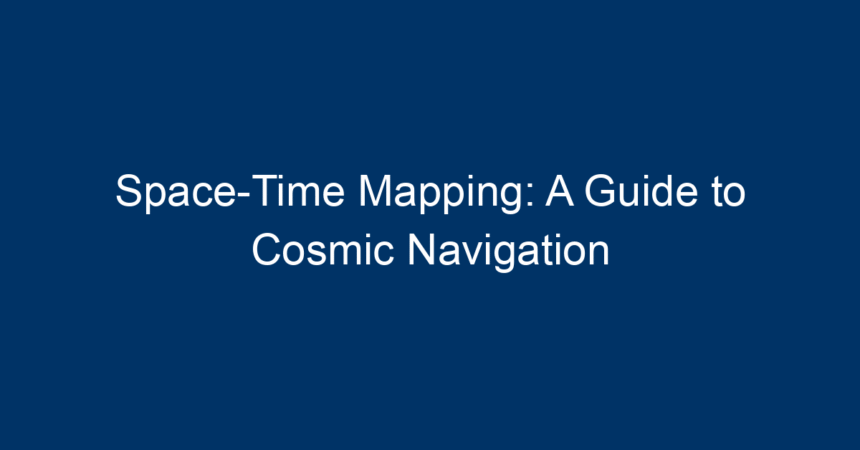In the vast expanse of the universe, navigating through space and time poses challenges that have long fascinated scientists, philosophers, and explorers alike. Enter space-time mapping—the sophisticated framework that allows us to visualize and understand our cosmic environment. This guide delves into the concepts, techniques, and implications of space-time mapping, inviting you to explore the universe like never before.
What is Space-Time Mapping?
At its core, space-time mapping is a method of representing the four-dimensional continuum of space and time as a single entity. Developed from Einstein’s Theory of Relativity, space-time mapping helps us grasp how objects move through the cosmos, taking into account their trajectory and the gravitational forces acting upon them.
The Basics of Space-Time
Before diving into mapping techniques, it’s essential to understand the fundamental principles of space-time itself. Space-time combines the three dimensions of space—length, width, and height—with the fourth dimension of time into a singular framework.
1. The Fabric of Space-Time
Think of space-time as a fabric that can be warped and stretched. Massive objects, like planets and stars, create indentations in this fabric, influencing the movement of other objects—an effect known as gravity. When we visualize these distortions, we can start to map out the relationships between various cosmic entities.
The Historical Context
Space-time mapping isn’t a new concept. It evolved from centuries of astronomical study, with key milestones including:
- Galileo’s Observations: Pioneering ideas about motion and inertia.
- Newton’s Laws: Formulating the relationship between force, mass, and acceleration.
- Einstein’s Theory of General Relativity: Revolutionizing our understanding by introducing the idea that gravity is a curvature in space-time.
These foundational concepts paved the way for modern mapping techniques and technologies.
Techniques of Space-Time Mapping
2. Coordinate Systems
To navigate the universe, we need a way to describe locations efficiently. Various coordinate systems are employed in space-time mapping:
- Galactic Coordinates: These coordinates measure distances from a central point in our galaxy, employing two angles and a distance metric.
- Equatorial Coordinates: A celestial coordinate system that utilizes the celestial equator as a reference, making it easier to pinpoint stars and constellations.
- Cartesian Coordinates: Often used in physics, this system represents positions in a three-dimensional space with (x,y,z) coordinates.
Advantages and Disadvantages
Choosing the right system depends on the application’s goals. For instance, galactic coordinates provide a broader view of our galaxy, while Cartesian coordinates offer precision for localized measurements.
3. Visualization Techniques
With advances in technology, visualization techniques for space-time mapping have improved significantly:
- 3D Models: Interactive simulations allow users to manipulate and explore environments in a virtual space.
- Data Visualization Tools: Software applications can convert numerical data into visually accessible formats, helping scientists identify patterns and anomalies.
- Augmented Reality (AR): AR provides an immersive experience, superimposing star maps and cosmic data onto the actual night sky.
4. Mathematical Frameworks
Mathematics underpins space-time mapping. Calculations involving tensors and metrics are essential for representing the curvature of space-time accurately.
- The Minkowski Metric: A mathematical description that combines spatial and temporal intervals, crucial for understanding how distances behave at high velocities.
- Fermi-Walker Transport: Methodologies for maintaining properties of objects as they move through curved space-time.
Modern Applications of Space-Time Mapping
5. Astronomy and Astrophysics
In astronomy, space-time mapping enhances our ability to explore celestial bodies. It aids in determining the trajectories of stars, planets, and even galaxies. Space telescopes like Hubble employ these mapping techniques to investigate the origins of the universe and the evolution of cosmic structures.
6. Navigation and Space Exploration
For space exploration, space-time mapping is crucial. If you’ve ever wondered how spacecraft navigate through the solar system, it all boils down to meticulously calculated space-time pathways.
- Interplanetary Travel: Spacecraft utilize gravity assists—where they gain speed and change direction by using the gravitational pull of planets—effectively mapping their routes in a dynamic, three-dimensional environment.
7. Quantum Physics and Black Holes
Space-time mapping also plays a vital role in quantum physics. Understanding phenomena like black holes—regions where space-time curvature becomes extreme—requires precise mapping techniques. The event horizon and singularity challenge our current comprehension of physics, but mapping these features helps physicists develop theories that may one day unify general relativity and quantum mechanics.
Challenges in Space-Time Mapping
8. Complexity of Data
One of the primary challenges in space-time mapping is managing the sheer volume of data generated by astronomical observations. Analyzing information from telescopes, satellites, and other instruments requires advanced computational techniques to filter and interpret essential insights.
9. Theoretical Limitations
Despite progress, there remain theoretical limitations to our understanding of space-time. Concepts such as dark matter and dark energy introduce complexities that current mapping techniques struggle to account for effectively. Ongoing research attempts to integrate these elements into existing frameworks.
Future of Space-Time Mapping
The future of space-time mapping holds immense promise. As technology evolves, we can expect:
- Enhanced Computational Power: Rapid advancements in computational capabilities will make it easier to process large data sets.
- AI and Machine Learning: Artificial intelligence can help identify patterns in complex datasets, revolutionizing the way we navigate and understand cosmic phenomena.
- International Collaboration: A growing trend toward collaborative efforts among space agencies worldwide will lead to more comprehensive mapping projects, uniting discoveries for global understanding.
Conclusion: Unlocking the Cosmos
Space-time mapping is more than a scientific endeavor; it is an invitation to explore the universe in new and exciting ways. By understanding the dimensional fabric of reality, we can enhance our cosmic navigation skills and deepen our appreciation for the mysteries that lie beyond our planet.
To harness the potential of space-time mapping:
- Stay Informed: Follow updates in astronomy and physics.
- Engage with Technology: Use apps and platforms that visualize stellar movements and cosmic events.
- Embrace Learning: Explore online courses or lectures about space-time concepts to broaden your understanding.
As you embark on your journey into the cosmos, remember that the universe is vast, and with each mapping effort, we draw closer to unlocking its secrets. 🌌




